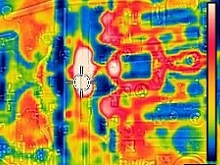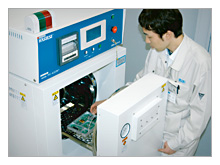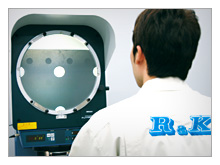Quality Assurance System
Quality Management System was derived from the concept of “Zero Defect “. Based on the concept, Quality Management System has been developed and expanded greatly. Every product in the market is expected to perform its function and maintain its quality for a long period of time. And it must be able to sufficiently withstand any possible overuse. With an aim to provide products that satisfied customers’ needs and expectations in a timely manner, R&K is committed to constantly develop and manufacture more and better advanced products. Unrelenting pursuit of excellence in quality, R&K is firmly engaged in the following Quality Management System activities.
- Planning, development and design of new products.
- Reliability analyses, and evaluations.
- Failure analyses and improvements.
Planning, Development, and Design of New Products
Based on R&K’s company policy, the concept and criteria of Quality Management System are applied and implemented as early as when a new product is being planned, developed and designed. In addition, the following 5 major elements of production (5M) are being evaluated at this stage.
- Methods (Methods of manufacturing)
- Material (Raw materials and parts)
- Machine (Equipments, measuring instruments, and tools)
- Man (Personnel)
- Measurement (Methods of measurements)
By carefully examine the 5Ms at early stage, R&K is in an effort to establish better production methods and produce high quality products.
- Methods (Methods of manufacturing)
To ensure stable manufacturing of products, manufacturing manuals are being used to clarify methods and procedures.
- Material (Raw materials and parts)
To ensure high-quality products, the use of appropriate raw materials and parts are essential. Every new material and part is being carefully evaluated before it is adopted into production. The evaluation criteria include a variety of view points, such as quality, reliability, price, lead time, competitiveness and durability.
- Machine (Equipments, measuring instruments, and tools)
To ensure quality, reliability and competitiveness of products, appropriate equipments, instruments and tools must be used in production processes. It is important to carefully study each production process of each product, half-finished product and part so that the best applicable equipments….etc can be used for each process. Paying attention to any new equipment which are adopted into production processes is necessary because all equipments, measuring instruments and tools…etc have certain and different effects on quality and performance of products. For the reason, advanced accuracy control is required for measuring instruments, or, measuring instruments, which provides standards for judgment would lose their roles as measures.To maintain the accuracy of measuring instruments at all time, R&K makes it obligatory to calibrate measuring instruments at least once a year. There are more than 200 sets of measuring instruments including network analyzers, spectrum analyzers, and synthesizersEtc in R&K today. Each of them is being periodically calibrated in a one-year cycle. A label with expiration date is applied on each instrument once the periodical calibration is conducted. Calibration results are detailed recorded and stored. Traceability control is a system enables to specify the accuracy of R&K’s measuring instruments and how it is linked to the applicable national standards. To ensure the accuracy of each measuring instrument conform as close as possible to the national standards, R&K outsources calibration work to JCSS-certified operators (officially certified calibration organizations) to control the traceability of R&K’s measuring instruments.
- Man (Personnel)
Retaining and training employees is the most important, and yet the most difficult task. The retention of employees who possess knowledge, skills and competencies is primary for every company. When developing new products, in most of the cases, completely new skills and knowledge is required. Therefore, constantly learning of new skills and knowledge is necessary for all the personnel in the company. Due to the fast growing (changing) market, it is required that new product development to be completed in a limited time. Consequently, learning new skills and knowledge in a limited time becomes relatively important.R&K will continually develop products that satisfy market needs. With a vision of future, R&K will continually provide education to all employees.
- Measurement (Methods of measurements)
R&K specify measurement methods and procedures in manuals, instructions…etc to ensure same measurement procedures are carried out and the stability of each measurement.
Reliability Test
After an initial drawing has been completed and a prototype based on the drawing has been made, it is when reliability and quality can be examined for the first time. Reliability tests evaluate and examine new developed product and are the core of all Quality Management System activities. They are not only for the purpose of evaluating new products, but also to identify failures in a system, provide clues for analyzing failed mechanism of devices, and determine stress limits in test criteria. Reliability tests are conducted sequentially in each of the development and subsequent stages of a system or apparatus according to the objectives of each stage. In Quality Management System stage, there are tests like, development tests, environmental tests, certification tests, before shipping tests…etc. In some cases, life tests and some specific tests are conducted added if necessary
evelopment tests or design development tests are conducted to assist development. Tests are: testing parts and items, simple tests using engineering models, system tests using “SYSTEMS” to be developed and assembled. The purpose of these tests is to improve and enhance development design. In a sense, simulation tests using development test software can be regarded as being part of development tests. Environment test are conducted by examining the conditions for using a system or apparatus in detail and replacing them with the environmental conditions in a laboratory or a constant-temperature bath. R&K conducts these tests with test methods based on applicable JIS standards. According to the environmental characteristics to be varied, environmental tests are classified into:
- Temperature tests (High-temperature, low-temperature, and high humidity tests)
- Vibration, impact, and drop tests
- Salt spray tests, corrosion resistance tests, and highly accelerated temperature and humidity stress tests….etc.
Temperature and humidity are two of the factors which needed to be taken into account while designing test criteria. Temperature tests must be conducted by assuming all sorts of harsh conditions, such as extreme temperature and humidity changes in dry and cold areas, location of installation, sunlight exposure, location of storage, and conditions of transportation. If a product is exposed to different climates and conditions for a long period of time, there is a possibility that it may undergo some changes in chemical or physical properties, such as oxidation, corrosion, abrasion, cracking and looseness. These changes will make the faulty or weak parts of products become conspicuous and have negative effects on performance of products or cause malfunctions.
Environmental conditions must be clarified, and the materials and parts used for finished products must be able to withstand different environmental conditions. Even when environmental resistant materials and parts are selected at design stage, there are possibilities that defective materials and parts are comprised within or losing environmental-resistant properties due to error processes. As the purpose of environmental tests is to prove that a product does not contain the results of above said defects, environmental tests must be conducted under the harshest conditions applied to the product.
Tests at final stage are carried out for evaluating and confirming performance and quality before shipments. One of the popular methods for tests is to draw samples from a system or product and disassemble them for inspection. Instead of sampling inspection, R&K conducts full inspection and using collecting and screening data methods to ensure zero damages to the products.
Life cycle tests are the most often cited of all reliability tests. Accelerated life cycle tests are conducted as ways for the purpose of shortening testing time and reducing expenses. They are aimed at attempting to shorten the test time by taking advantage of the fact that the life cycle will be shorter as the stress level increased. One problem is in what way stress level should be increased. If the failure mode due to increases in stress, then the accelerated life cycle tests will be meaningless. For conversion, failures must be detected in the same mode, and must be due to the same mechanism. If the failure mechanism can be determined, the rate of acceleration can also be determined, and the accelerated life test will be effective.
In a wider aspect, special tests are conducted to examine the stability of a product over time, failure rate, MTBF, etc. For mass-produced parts, special tests are conducted on parts which likely pass environmental tests. As, special tests require longer test time and more samples needed to be drawn than environmental tests. In other words, special tests are destructive tests.
-

Thermographic imaging equipment enables infrared images of large amount of high-frequency amplifiers to be drawn and determine problems at once.
-

This HAST tester enables unsaturated steam pressurization tests such as migration and humidity intrusion due to humidity while performing actual high frequency operation with the DUT power turned on.
-

The screen projector is designed to digitally display the finished dimensions of a finished product. With its mounted turntable, in particular, it provides accurate angle measurement.
Failure Analyses and Improvement
Failure analysis is one of the essential tasks for improving reliability of products. Product reliability will be improved only if failure analyses are conducted at all stages of developing, designing, prototyping, manufacturing and using to investigate causes of errors and failures. R&K believes reliability improvement or Quality Management System without conducting failure analyses is inconceivable. When complaints occur, R&K customer services department will first inquire details of failures on the phone and then request a send back for detailed inspections and investigations products to find out the causes of defects.
- Failures of parts used inside
- Inappropriate manufacturing
- Insufficient process control
- Ambiguous quality standard or inspection item
- Inspection error or incomplete inspection management
- Changes in quality during transport or storage
- Careless handling by users.
In response to complaints, R&K conducts failure analyses immediately as defected products arrive and provide customers with a detailed written report to explain the failure occur. In addition, R&K investigate the possibility of potential failures that have not yet been found and take action to prevent that happens in the future. R&K‘s customer service department is in charge of investigating and analyzing failures. Causes of failures must be accurately determined and take appropriate countermeasures and endeavors to prevent the same the defects from recurrence.
The inspection department is notified of data used for analysis and the details of accidents. By the reference of the data, the inspection department will take action to re-study the current inspection methods and hence to take appropriate actions to improve Quality Management System assurance functions if necessary.

